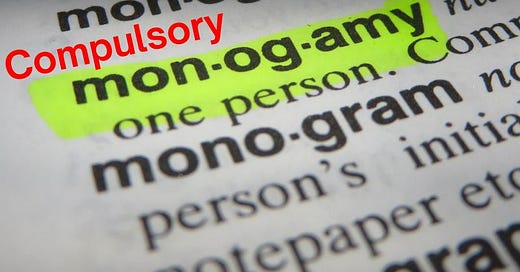Beyond the Nuclear Family: Unraveling Norms & Embracing the Spectrum of Relationships (Part 3)
This is Part 3 in a seven-part series. This part critiques compulsory monogamy.
This is Part 3 in a seven-part series. To start at the beginning, click here!
Critiquing Compulsory Monogamy and the “All-or-Nothing” Mindset
Compulsory monogamy, the societal expectation that monogamous relationships are the only valid or moral choice, has long been a cornerstone of the nuclear family model. This expectation is not merely a personal preference, but a deeply ingrained norm that shapes legal, social, and economic structures, often marginalizing those who choose alternative paths.
Compulsory monogamy serves as a potent form of social conditioning that reinforces the nuclear family as the idealized family structure. This conditioning is deeply embedded in cultural narratives, legal systems, and educational materials, presenting monogamy as not just the norm, but the only morally and socially acceptable choice for intimate relationships. This widespread promotion subtly coerces individuals into buying into the nuclear family paradigm, often without questioning its relevance or suitability to their personal desires and needs.
The insistence on compulsory monogamy fails to acknowledge the complexity and diversity of human relationships. It imposes a standard solution to love and partnership, ignoring the varied ways people connect, love, and build lives together. This monolithic view of relationships limits personal autonomy and choice, often at the cost of individual happiness and fulfillment.
By championing compulsory monogamy, society upholds the nuclear family as the cornerstone of social organization. This not only marginalizes alternative family structures, but also perpetuates the notion that successful adult life hinges on entering and maintaining a monogamous marriage and being a productive capitalist. This narrative is so pervasive, it shapes individual identities and life goals, steering public and private resources towards sustaining the nuclear family model.
Marriage, as a legal and cultural institution, encapsulates the “all-or-nothing” approach. It demands exclusive emotional, sexual, and often financial commitment, sidelining other forms of relationships that might offer different benefits and fulfillments. This mindset not only constrains the spectrum of possible relationships, but also creates a binary of legitimate and illegitimate connections, often devaluing and eliminating the possibility of some friendships, community bonds, and other non-sexual partnerships.
The insistence of compulsory monogamy, coupled with the “all-or-nothing” mindset, breeds fear and insecurity. Jealousy, feelings of ownership over another person, fears of cheating, and “break-ups” are amplified in a culture that views any deviation from monogamy as a threat to social order. These fears are often unfounded and overlook the potential for individuals to develop the trust, communication skills, and emotional intelligence necessary for navigating complex relationships.
The pressure to conform to compulsory monogamy and the “all-or-nothing” framework can stifle personal growth and exploration. It encourages dependency over independence, uniformity over diversity, and often leads to the entrenchment of traditional gender roles. Furthermore, the expectation of finding all emotional, physical, and intellectual fulfillment in a single person is not only incredibly ambitious but can also place undue strain on relationships, contributing to high rates of dissatisfaction and divorce.
The rigid expectations set by compulsory monogamy and the nuclear family model contribute significantly to high divorce rates. When individuals are pressured into fitting their complex emotional and relational needs into a standardized box, dissatisfaction and disillusionment are sure to follow for at least some people. The “all-or-nothing” mindset leaves little room for negotiation, growth, or change within relationships, often leading to their dissolution when the idealized image of monogamy and marriage is not met.
Recognizing the limitations of compulsory monogamy opens the door to exploring alternative relationship models that are more flexible, consensual approaches to love and partnership, emphasizing communication, consent, and respect for autonomy. By challenging the “all-or-nothing” mindset, individuals and communities can foster relationships that are more aligned with their needs, values, and capacities for love.
Challenging the societal conditioning of compulsory monogamy opens up more possibilities for reimagining relationships on terms that prioritize personal fulfillment, mutual respect, and emotional well-being. It opens up more possibilities for secure, honest, and flexible relationship dynamics. By deconstructing the pillars of the nuclear family and compulsory monogamy, society can move toward a more inclusive understanding of love and partnership, one that celebrates diversity and adaptability over rigid conformity.
This critique of compulsory monogamy and the “all-or-nothing” mindset is not an indictment of monogamy itself but a call to broaden our understanding of relationships beyond the narrow confines of the nuclear family model. Embracing a wider spectrum of relationship structures allows for a more inclusive, flexible, and compassionate society where all forms of love and connection are valued. By questioning these norms, we invite a richer, more diverse conversation about what it means to love and live together sustainably.
Next time, in Part 4, I’ll talk about a way of looking at relationships on a spectrum instead of the simplistic, binary way relationships are often characterized.





